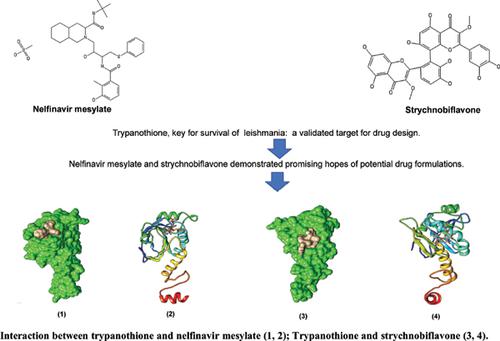Letters in Drug Design & Discovery ( IF 1.2 ) Pub Date : 2021-06-30 , DOI: 10.2174/1570180817999200730171556 Sagar Bhowmik 1 , Md. Shamim Akhter 1

|
Background: Visceral leishmaniasis, the most lethal form of Leishmaniasis, is caused by Leishmania donovani in the Indian subcontinent and East Africa. Current therapeutics for the disease is associated with a risk of high toxicity and development of drug-resistant strains. Thus, the discovery of potential targets, successful inhibitors, and improved drug distribution mechanisms for leishmaniasis diagnosis has become a focus.
Objective: Hydroperoxide metabolism involving trypanothione, key for the survival of Leishmania, is a validated target for rational drug design. In this study, we aim in silico drug design by targeting tryparedoxin peroxidase (2-Cysperoxiredoxin type) from Leishmania donovani (LdTXNPx) using clioquinol, nelfinavir, and strychnobiflavone as mother compound. Clioquinol, nelfinavir are known for their anti-leishmanial activity and strychnobiflavone showed antileishmanial activity against Leishmania amazonensis and Leishmania infantum amastigotes and promastigotes recently.
Methods: On this basis, we constructed protein structure using homology modeling, molecular docking of protein with potential drug candidates, interaction analysis and pharmacophore analysis conducted in this study.
Results: We have revealed two compounds i.e. Nelfinavir mesylate and strychnobiflavone, which have desired characteristics in the future drugs for Visceral leishmaniasis.
Conclusion: Consistently in the future, we will ratify the efficacy of these compounds, essential animal and clinical trials are needed to be performed. We believe that our present study will help to find efficient and effective therapy for treating Visceral leishmaniasis in humans.
中文翻译:

人类内脏利什曼原虫利什曼原虫锥体氧还蛋白过氧化物酶的计算分子对接研究
背景:内脏利什曼病是最致命的利什曼病,由印度次大陆和东非的多诺瓦利什曼原虫引起。目前对该疾病的治疗方法与高毒性和耐药菌株发展的风险有关。因此,发现用于利什曼病诊断的潜在靶点、成功的抑制剂和改进的药物分布机制已成为关注的焦点。
目的:涉及锥虫的氢过氧化物代谢是利什曼原虫存活的关键,是合理药物设计的有效靶点。在这项研究中,我们的目标是通过使用氯碘喹诺、奈非那韦和马钱子黄酮作为母体化合物,靶向来自多诺瓦尼原虫 (LdTXNPx) 的色氨酸过氧化物酶(2-环氧还蛋白类型)进行硅酮药物设计。氯碘喹诺、奈非那韦以其抗利什曼原虫活性而闻名,而马钱子黄酮最近对亚马逊利什曼原虫和婴儿利什曼原虫无鞭毛体和前鞭毛体显示出抗利什曼原虫活性。
方法:在此基础上,我们利用同源建模、蛋白质与潜在候选药物的分子对接、相互作用分析和药效团分析构建了本研究中的蛋白质结构。
结果:我们揭示了两种化合物,即甲磺酸奈非那韦和马钱子黄酮,它们在未来的内脏利什曼病药物中具有所需的特性。
结论:在未来,我们将始终如一地批准这些化合物的功效,需要进行必要的动物和临床试验。我们相信,我们目前的研究将有助于找到治疗人类内脏利什曼病的有效疗法。











































 京公网安备 11010802027423号
京公网安备 11010802027423号